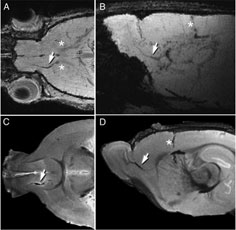How to track neuronal stem cells using MRI
October 3, 2011

MRI imaging can be used to follow the migration of neuroblasts tagged with a ferritin-based reporter. Tagged cells are pointed out by the white arrows (Credit: CMU)
Carnegie Mellon University biologists have developed an MRI-based technique that allows researchers to non-invasively follow neural stem cells as they migrate into other areas of the brain and mature into neurons.
The technique could help teach scientists how to redirect these stem cells into areas of the brain that need repair, suggesting new treatments for brain injury caused by trauma, stroke, Parkinson’s disease and other neurological disorders.
The research was led by Eric Ahrens, associate professor of biological sciences, and postdoctoral student Bistra Iordanova.
Regenerating brain cells
Legend had it that once a brain cell dies, it’s lost forever. Neuroscientists have now proven that the brain is constantly producing new neurons. These are created from neural stem cells born deep in an area of the brain called the subventricular zone. As time goes on, the neural stem cells, or neuroblasts, make their way to other areas of the brain, where they mature into functioning neurons.
The brain’s ability to regenerate its cells is of great interest to scientists. “If we could better understand the molecular migratory signals that guide neuroblasts, we could try to redirect these cells to areas of the brain harmed by stroke or traumatic brain injury. With this information, scientists might be able to one day repair the brain,” said Ahrens, who also is a member of the Pittsburgh NMR Center for Biomedical Research.
Tracking neuroblasts in the brain
But studying cells in a living brain is problematic. Common forms of in vivo cell imaging like fluorescence and bioluminescence rely on light to produce images, making them unsuitable for viewing neuroblasts buried deep beneath the skull and layers of opaque tissue. Until now, scientists had only been able to study neuronal stem cells by looking at slices of the brain under a microscope. Ahrens was able to surmount this problem by using MRI technology.
Rather than light, MRI uses a magnetic field and radio frequency pulses to cause the hydrogen protons found in the body’s water molecules to give off signals. Those signals are converted into a high-resolution image.
At the foundation of this work is a technology Ahrens developed that causes cells to produce their own contrast agent, allowing them to be imaged with MRI. Using a viral vector, Ahrens incorporated the gene that produces the naturally occurring metalloprotein ferritin into living cells. Ferritin, which is present in all biological cells, harvests and stores naturally occurring iron.
When the cells tagged with ferritin begin to produce increased amounts of the protein, they draw in additional iron, turning themselves into nanomagnets. This disrupts the magnetic field surrounding the tagged cells, changing the signal given off by adjacent water molecules. This change appears as dark spots on the MRI image, indicating the cells’ presence.
Iordanova and Ahrens used this technique for tagging neuroblasts with the engineered ferritin. They incorporated the DNA sequence for the engineered metalloprotein into an adenovirus vector, which they then injected into the subventricular zone of a rat brain. The adenovirus infected the neural stem cells, giving the cells the genetic instructions to begin producing the ferritin reporter.
Iordanova then imaged the brain with MRI and found that she was able to follow — in real time — the neuroblasts as they traveled toward the olfactory bulb and ultimately formed new inhibitory neurons. These results mirrored what had been observed in histology studies.
Ahrens hopes to continue to develop the technology to allow researchers to better understand neuronal stem cells and how neurons regenerate. He also plans to use the reporters to improve clinical trials of cell-based therapies.
By incorporating the reporter into the cells before implantation, researchers would be able to find the answer to a number of critical questions. “Where do these cells go, days, weeks and months later? How do we know that they’ve grafted to the right cells? Or have they grafted in the wrong place? Or died?” Ahrens asked. “The reporter can show us the answers.”
Ref.: Bistra Iordanova, Eric T. Ahrens, In vivo magnetic resonance imaging of ferritin-based reporter visualizes native neuroblast migration, NeuroImage, 2011; [DOI:10.1016/j.neuroimage.2011.08.068]
